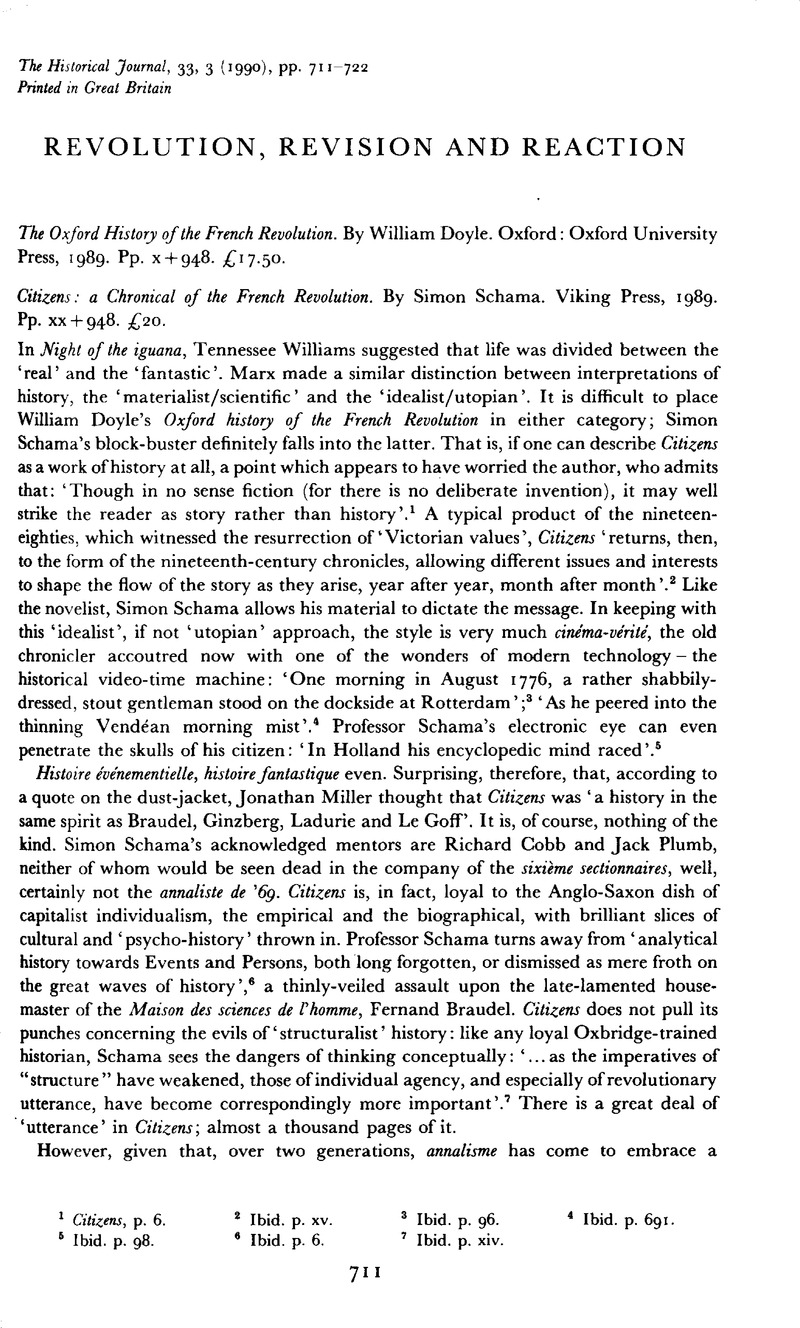No CrossRef data available.
Published online by Cambridge University Press: 11 February 2009

1 Citizens, p. 6.
2 Ibid. p. xv.
3 Ibid. p. 96.
4 Ibid. p. 691.
5 Ibid. p. 98.
6 Ibid. p. 6.
7 Ibid. p. xiv.
8 See my introduction to Soboul, A., The French revolution, 1787–1799 (London, 1989)Google Scholar.
9 The French revolution and the creation of modern political culture, 3 vols. (Oxford, 1987–)Google Scholar.
10 Citizens, pp. 635–6.
11 Oxford history of the French revolution, p. 392.
12 Ibid. p. 23.
13 Ibid. p. 22.
14 See pp. 26–38, particularly p. 27 on the attempts by several parlements to exclude ‘bourgeois from the most desirable public employments’.
15 Ibid. p. 423.
16 Citizens, p. 290.
17 Ibid. p. 131.
18 Ibid. pp. 152–3.
19 Taylor, G., ‘Types of capitalism in eighteenth-century France’, English Historical Review, LXXIV (1964)Google Scholar; and ‘Non–capitalist wealth and the origins of the French revolution’ American Historical Review, LXXII (1967)Google Scholar.
20 Chaussinand-Nogaret, G., The French nobility in the eighteenth century: from feudalism to enlightenment (Cambridge, 1985), p. 114CrossRefGoogle Scholar.
21 Citizens, pp. 190–1.
22 My book, provisionally entitled Ancien régime, revolution and the rise and fall of industrial capitalism in the south-east of France, 1770–1830 will be published by Oxford Universit Press.
23 Oxford history, pp. 12–13.
24 The French nobility in the eighteenth century, ch. five.
25 Oxford history, p. 28.
26 For a résumé of my argument concerning Pierre-François Tubeuf and his abortive attempts to introduce l'industrie en grand in the Alès coal-basin see the special issue of the Revue du Nord, La Révolution Française et le développement du capitalisme (Lille, 1989), pp. 243–55Google Scholar.
27 Oxford history, p. 23.
28 See, for example, ‘…it is equally hard to believe that the specifically anti-aristocratic, anti-feudal revolutionary ideology of the Rights of Man could have emerged as it did without the jumble of accident, miscalculation and misunderstanding which coalesced into a revolution in specifically French circumstances’, Oxford history, p. 424.
29 Citizens, p. xvi.
30 Furet, François and Richet, Denis, La Révolution: des é;tats géné;raux au 9 thermidor (Paris, 1965)Google Scholar. The similarity between the approach adopted in this work and that of Professor Schama is striking. Richard Cobb, referring to the illustrations included by Furet, and Richet, , wrote: ‘Here is at least the public, dramatic, solemn, and brutal face of the Revolution – journées, severed heads, battles, burning buildings, dead soldiers, massacres and murders, speeches, solemn occasions, processions, fetes, Te Deums godly and pagan, recruiting platforms, rīots. But there is little to illustrate hope, optimism, candour, generosity, fraternity, enthusiasm, the pride of citizenship…’ Second identity: essays on France and the French history (Oxford, 1969), p. 83Google Scholar.
31 Citizens, pp. 330–1.
32 Ibid. p. 748.
33 Ibid. p. 648.
34 Ozouf, M., L'Homme régénéré: essais sur la Révolution française (Paris, 1989), pp. 106–7Google Scholar.
35 Citizens, p. 615.
36 Ibid. p. 860.
37 Ibid. p. 859.
38 Ibid. J. Bosher, The French revolution (London, 1989), p. 42.
39 Ibid. p. 45.
40 Citizens, p. 741.
41 Ibid. p. 551.
42 Ibid. pp. 399–400.
43 Ibid. pp. 609–18.
44 Ibid. pp. 630–9.
45 Oxford history, p. 207.
46 Ibid. p. 208.
47 Ibid. p. 343.
48 See Sutherland, D., France, 1789–1815: revolution and counterrevolution (London, 1985)Google Scholar which is a fine résumé of recent research on the period but which exaggerates the scope of the resistance to the revolution. Naturally, Professor Schama thinks that this work is ‘one of the most remarkable histories to have appeared for a long time’, although he eventually nails his colours to Cobban's, AlfredSocial interpretation of the French revolution, ‘once thought so scandalous’, Citizens, p. 906Google Scholar. I actually think that this collection of lectures has been vastly overrated, but then I am not easily scandalized.
49 Oxford history, p. 111.
50 Ibid. p. 106.
51 Lewis, G., The second Vendée: the continuity of counter-revolution in the department of the Gard (Oxford, 1978)Google Scholar, ch. one.
52 Lyons, M., France under the directory (Cambridge, 1975), p. 37Google Scholar.
53 Blanning, T. C. W., The origin of the French revolutionary wars (London, 1986, p. 122Google Scholar.
54 Oxford history, pp. 152 and 194.
55 Citizens, pp. 591–2.
56 Ibid. p. 724.
57 Ibid. p. 815.
58 Ibid. p. 852.
59 Ibid. p. 557.
60 Bosher, , The French revolution, p. 278Google Scholar.
61 Jones, P., The peasantry in the French revolution (Cambridge, 1988)Google Scholar.
62 Vansittart, P., Voices of the Revolution (London, 1989), p. 354Google Scholar.